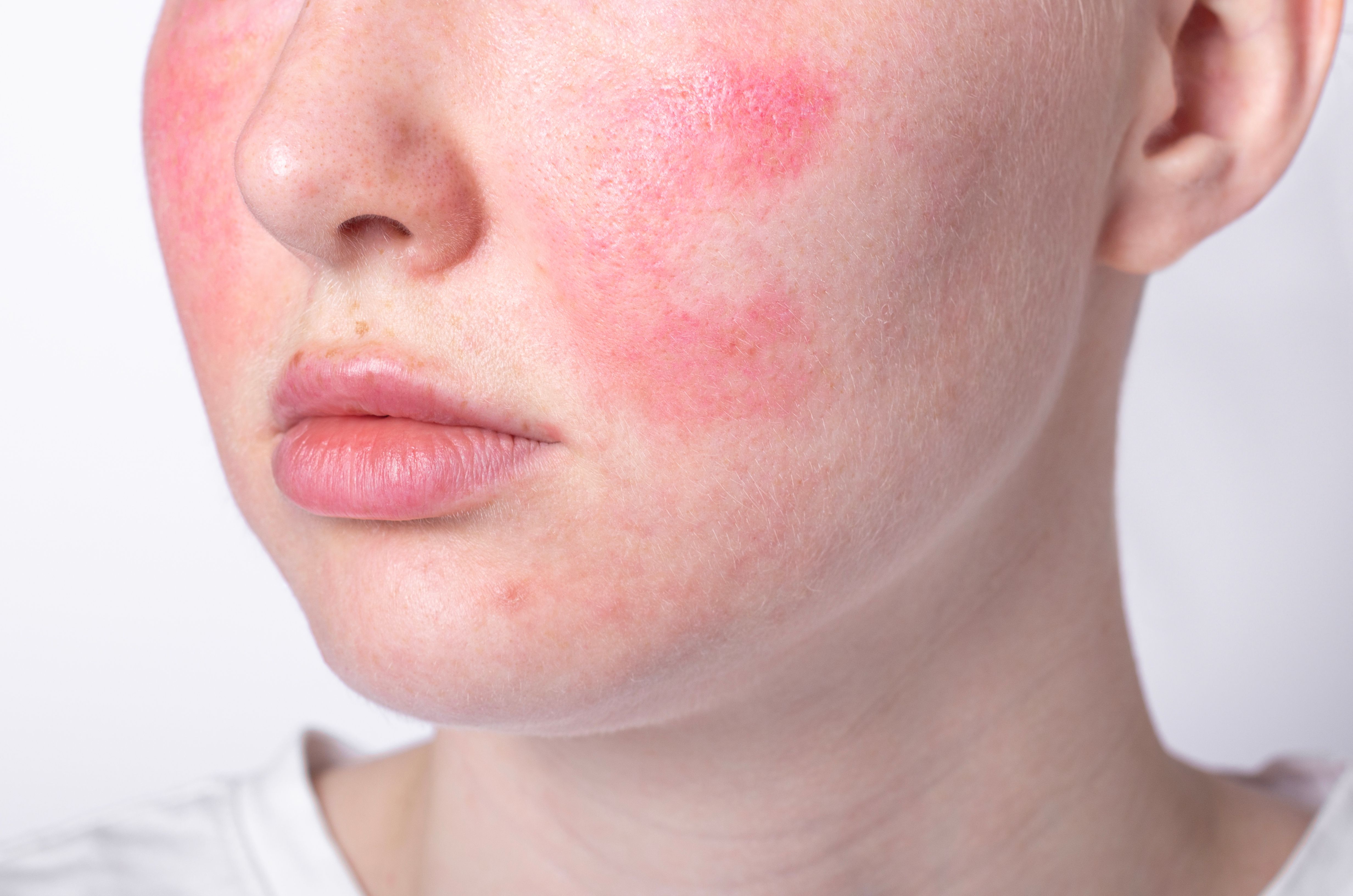- Acne
- Actinic Keratosis
- Aesthetics
- Alopecia
- Atopic Dermatitis
- Buy-and-Bill
- COVID-19
- Case-Based Roundtable
- Chronic Hand Eczema
- Chronic Spontaneous Urticaria
- Drug Watch
- Eczema
- General Dermatology
- Hidradenitis Suppurativa
- Melasma
- NP and PA
- Pediatric Dermatology
- Pigmentary Disorders
- Practice Management
- Precision Medicine and Biologics
- Prurigo Nodularis
- Psoriasis
- Psoriatic Arthritis
- Rare Disease
- Rosacea
- Skin Cancer
- Vitiligo
- Wound Care
Article
Recognizing and Treating Rosacea in Skin of Color
Author(s):
Hilary Baldwin, MD, presented on how to recognize, diagnose, and treat rosacea in patients with skin of color at the Skin of Color Update 2021.
In a presentation at the Skin of Color Update 2021, held virtually September 10-12, Hilary Baldwin, MD, dermatologist, medical director at the Acne Treatment and Research Center in Brooklyn, New York, and assistant professor at Rutgers Robert Wood Johnson Center in New Brunswick, New Jersey, explained the need to recognize, diagnose, and treat rosacea in patients with skin of color (SOC).1
It was found in a survey that 2% of patients diagnosed with rosacea identify as Black, 2.3% as Pacific Islander, 3.9% as Hispanic or Latino, according to research that Baldwin quoted2. She quoted the paper which said, “Patients of color rarely receive a diagnosis of rosacea, even when they have symptoms suggesting it.”
When the patients were separated into two categories Fitzpatrick Phototype [FPT] I-III vs FPT IV-V, the percentages were 93.4% vs 6.6%, but when the categories are FPT I-IV vs FPT V-VI they are 99.8% vs 0.2%. Baldwin suggested this difference in diagnosis could be because erythema and telangiectasia are harder to identify in darker skin types.
If the correct diagnosis is not made, Baldwin warned, it can lead to incorrect or inadequate treatment, symptoms persisting for a year or more, increased morbidity, decreased quality of life (QOL), and more advanced disease (sight threatening disease, disfiguring phymas, and persistent telangiectasia).
Baldwin states that rosacea occurs in patients who are genetically predispositioned, such as family history, twin concordance, association with autoimmune disorders, and an association with Human Leukocyte Antigen (HLA) alleles, but it is poorly understood. However, Baldwin continued, environmental factors do a play a role in severity and incidence of disease, those factors being ultraviolet exposure, alcohol, smoking, age, and cardiac comorbidity.
The signs of rosacea in SOC patients are:
- Erythema
- Telangiectasias
- Papules and pustules
- Phyma
Two papers that Baldwin found stated that there were no post inflammatory changes to the skin. She explained that the reason that acne causes post inflammatory changes could be because acne is folliculocentric and the inflammation tends to be deeper than rosacea.
The symptoms of rosacea in SOC patients are:
- Stinging, burning
- Pruritus
- Sensations of warmth (may be episodic)
- Painful eyes, gritty feeling of eyes, and rheum
- Sensitivity to skin products and medications
- Sun exposure can worsen these symptoms
Differential diagnoses typically include acne, steroidal acne, contact dermatitis, seborrheic dermatitis, periorificial dermatitis, facial Afro-Caribbean childhood eruption, keratosis pilaris rubra, lupus, sarcoidosis, and dermatomyositis.
Treatment for rosacea in SOC patients is the same as any other patient, according to Baldwin, and physicians should discuss symptoms, signs, goals, expectations, avoid post inflammatory hyperpigmentation (PIH), and aim for clearance.
“I ask [my patients] what out of all the [signs] I showed you actually bothers you?” Baldwin said. This way, instead of having a patient start what could be a costly and complicated treatment, they can focus on the most important factors.
The best tolerability data currently, according to Baldwin, is ivermectin cream 1% and minocycline 1.5% foam, but these medications may not be available in the next few months. To help avoid PIH in other ways include moisturizing, barrier repaid, and decreasing the vasoconstrictors. She predicts that microencapsulated benzoyl peroxide 5% will also be well tolerated because of its shell slowing down the process in which the benzoyl peroxide migrates to the skin.
Skin care regimen, according to Baldwin, is very important in rosacea treatment. She said a patient should use gentle, fragrance-free cleansers (once a day at night), a silicone-based moisturizer, light water-based cosmetics, and physical sunblock. It is also important to avoid alcohol-based cleansers, astringents, or abrasive exfoliating cleansers along with nonsilicone-based moisturizers, cosmetics with iridescent effects, and chemical sunscreens (if a patient has reported a sensitivity).
She also mentioned that a patient needs to be taught to fard appropriately, which, according to the dictionary, means to apply cosmetics in order to conceal facial blemishes.
“To fard appropriately, you want to avoid heavy cosmetics that are going to require make up removal or scrubbing,” Baldwin explained. “If there is a lot of erythema, adding a liquid green tint to the foundation might help to reduce that erythema.” She also said using quality emollients like silicone prior to make up application and having a matte finish may help with symptoms.
Baldwin ended the presentation with a recommendation to add general health questions to an intake form to scan for comorbidities. She further explained that because not much is known about the comorbidities, it may cause unneeded stress on a patient to ask them about it directly. Comorbidities relating to the gut, like microbiological reverberations, and how the gastrointestinal issues might be related to skin issues such as rosacea. Baldwin brought up that treatment of Inflammatory Bowel Disease (IBD) with rifaximin (Xifaxan; Bausch Health) has been shown to improve rosacea.
She summarized her presentation saying:
- Keep a high awareness/suspicion of rosacea
- Do a thorough history with the patient
- Have a careful examination
- Try to avoid delays in both diagnosis and treatment
- Reduce progression of disease
Disclosure:
Baldwin:
Advisory Board for Almirall, EPI Health, Galderma, Johnson & Johnson, LaRoche-Posay, Ortho Dermatologics, Sol-Gel, Sun, and Vyne.
Speakers bureau for Almirall, Galderma, LaRoche-Posay, Sun, Ortho Dermatologics, Vyne.
Investigator for Galderma, Ortho Dermatologic, and Vyne.
Reference:
- Baldwin. H. Recognizing, Diagnosing, and Treating Rosacea in Patients with Skin of Color. Presented at the: Skin of Color Update; September 10, 2021; Virtual.
- Al-Dabagh A, Davis SA, McMichael AJ, Feldman SR. Rosacea in skin of color: not a rare diagnosis. Dermatol Online J. 2014;20(10):13030/qt1mv9r0ss.
Newsletter
Like what you’re reading? Subscribe to Dermatology Times for weekly updates on therapies, innovations, and real-world practice tips.














